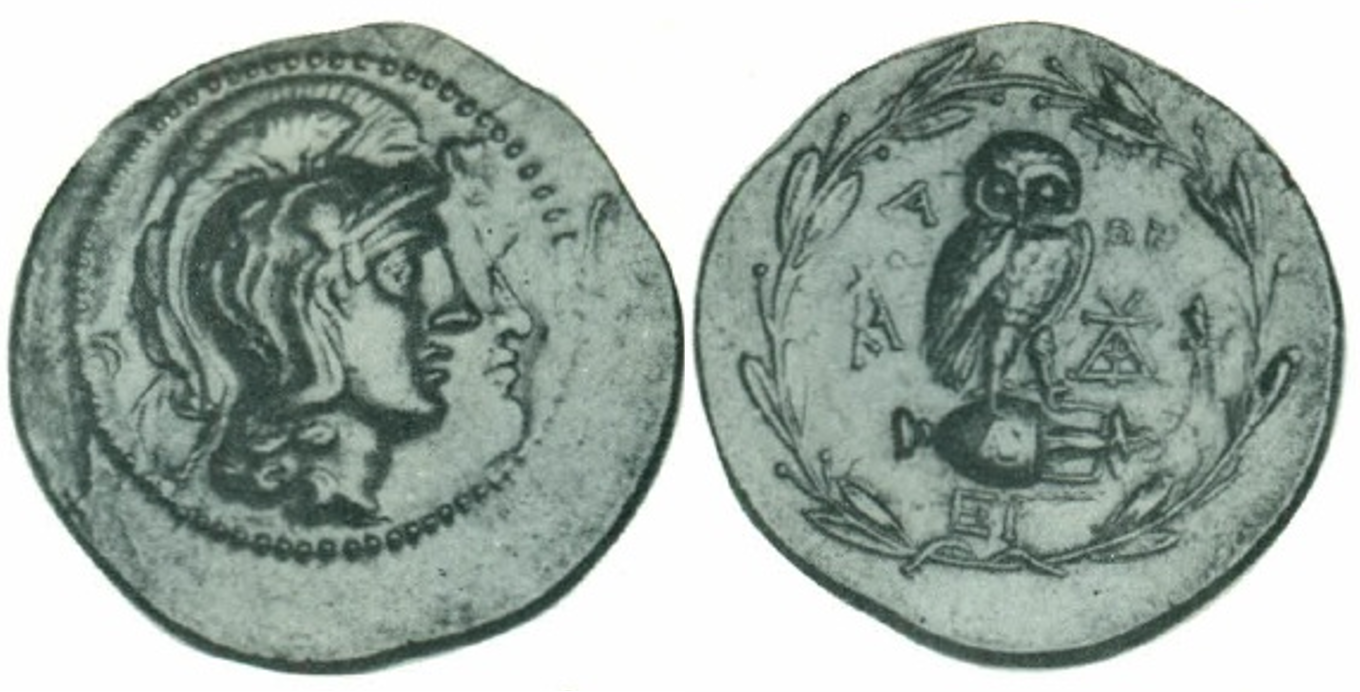3492 - Athens (tetradrachm Athena/owl) over uncertain Hellenistic ruler (Myers, FPL, March 1974, 62)
From SILVER
(CSV import-Overstrikes-2022-08-16) |
|||
| Line 1: | Line 1: | ||
{{Overstrike | {{Overstrike | ||
| − | |Sale=Myers FPL | + | |Image overstriking coin=Myers_62.png |
| + | |Image reference overstriking coin=https://www.jstor.org/stable/43573623?seq=1 | ||
| + | |Sale=Myers FPL, March 1974, no. 62. | ||
|Obverse description=Head of Athena right, wearing crested Attic helmet. Border of dots. | |Obverse description=Head of Athena right, wearing crested Attic helmet. Border of dots. | ||
|Reverse legend=AΘE | |Reverse legend=AΘE | ||
| + | |Reverse legend language=Greek | ||
|Reverse description=Owl right and amphora. In field, monograms. All within oliv wreath. | |Reverse description=Owl right and amphora. In field, monograms. All within oliv wreath. | ||
|Mint=Athens | |Mint=Athens | ||
|Ancient region=Attica | |Ancient region=Attica | ||
| − | |Date from= | + | |Date from=176 BCE |
| − | |Date to= | + | |Date to=142 BCE |
| + | |Period=Hellenistic | ||
| + | |Metal=Bronze | ||
|Weight=16.82 | |Weight=16.82 | ||
| − | |Denomination= | + | |Denomination=tetradrachm |
|Standard=Attic | |Standard=Attic | ||
| − | |Coin reference= | + | |Coin reference=Bauslaugh 1987, pl. 2, n°2 |
| − | |Coin series reference= | + | |Coin series reference=Thompson 1961, n°177; HGC 4, n°1602 |
| − | |Overstruck mint= | + | |Coin series web reference=https://greekcoinage.org/iris/id/athens.thompson_1961.169bis-183 |
| + | |Overstruck reverse description=Zeus stg. crowning royal name. | ||
| + | |Overstruck mint=Bithynia (uncertain mint) | ||
|Overstruck ancient region=Bithynia | |Overstruck ancient region=Bithynia | ||
|Overstruck authority=Kingdom of Bithynia (late 4th c.-74 BC) | |Overstruck authority=Kingdom of Bithynia (late 4th c.-74 BC) | ||
| + | |Overstruck date from=182 BCE | ||
| + | |Overstruck date to=127 BCE | ||
| + | |Overstruck period=Hellenistic | ||
|Overstruck denomination=tetradrachm | |Overstruck denomination=tetradrachm | ||
| + | |Frequency of overstrikes=frequent | ||
| + | |Level of confidence=strong | ||
| + | |Remarks="Portraits of Prusias II (ca. 182-149) and Nikomedes II (149-ca. 127) [...] corresponds both in position and outline to the trace preserved on the Athenian reverse" | ||
}} | }} | ||
Revision as of 10:51, 3 May 2024
176 BCE - 142 BCE | AΘE
Images
Overstriking coin

Myers_62.png [1]
Location/history
| Sale(s)Sale(s) ᵖ: | Myers FPL, March 1974, no. 62. | |
Overstriking coin
Description
| ObverseInscription or printing placed on the obverse.: | Head of Athena right, wearing crested Attic helmet. Border of dots. | ReverseInscription or printing placed on the reverse.: | AΘE (Greek) Owl right and amphora. In field, monograms. All within oliv wreath. |
Mint and issuing power
| MintIdentifies the place of manufacture or issue of a numismatic object.: | Athens | Ancient regionAncient region. | Attica | Modern countryModern country: Greece | AuthorityIdentifies the issuing power. The authority can be "pretended" when the name or the portrait of X is on the coin but he/she was not the issuing power. It can also be "uncertain" when there is no mention of X on the coin but he/she was the issuing power according to the historical sources: |
Chronology
| FromIdentifies the initial date in a range assigned in a numismatic context. 176 BCE toIdentifies the final date in a range assigned in a numismatic context.. 142 BCE | Hellenistic 323-30 BC |
Physical description
| MetalThe physical material (usually metal) from which an object is made.: Bronze |
WeightWeight of the numismatic object (in grams). in grams: 16.8216.82 g <br />16,820 mg <br /> | DenominationTerm indicating the value of a numismatic object. Examples: tetradrachm, chalkous, denarius.: tetradrachm |
|
| StandardStandard.: Attic | |||
References
| Coin referenceReference of the Coin: | Bauslaugh 1987, pl. 2, n°2 | Coin series referenceReference to coin series study: | Thompson 19611Thompson 1961, n°177, HGC 42HGC 4, n°1602 |
| Coin series web referenceCoin series web references: | |||
Overstruck type
Description
| ObverseInscription or printing placed on the obverse.: | ReverseInscription or printing placed on the reverse.: | Zeus stg. crowning royal name. |
Mint and issuing power
| MintIdentifies the place of manufacture or issue of a numismatic object. ᵖ: | Bithynia (uncertain mint) | Ancient regionAncient region. ᵖ | Bithynia | Modern countryModern country: | AuthorityIdentifies the authority in whose name (explicitly or implicitly) a numismatic object was issued. ᵖ: | Kingdom of Bithynia (late 4th c.-74 BC) |
Chronology
| FromIdentifies the initial date in a range assigned in a numismatic context. 182 BCE toIdentifies the final date in a range assigned in a numismatic context.. 127 BCE | Hellenistic 323-30 BC |
Physical description
| DenominationTerm indicating the value of a numismatic object. Examples: tetradrachm, chalkous, denarius. ᵖ: | tetradrachm |
References
| Coin type referenceReference to coin series study ᵖ: |
Additional data
| Frequency of overstrikesFrequency of overstrikes: | frequent | Level of confidenceLevel of confidence of the identification: | strong |
| RemarksRemarks: | "Portraits of Prusias II (ca. 182-149) and Nikomedes II (149-ca. 127) [...] corresponds both in position and outline to the trace preserved on the Athenian reverse" | ||
References
- ^ Thompson, Margaret (1961), The new style silver coinage of Athens, Numismatic Studies 10, New York, 2 vol.
- ^ Hoover, Oliver D. (2014), Handbook of Greek Coinage Series 4. Northern and Central Greece : Achaia Phthiotis, Ainis, Magnesia, Malis, Oita, Perrhaibia, Thessaly, Akarnania, Aitolia, Lokris, Phokis, Boiotia, Euboia, Attica, Megaris and Corinthia, sixth to first centuries BC, Lancaster, lxxi, 563 p.